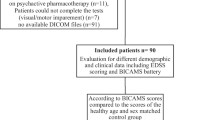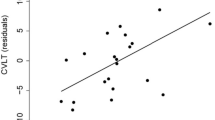Abstract
Cognitive disorders occur in up to 65 % of multiple sclerosis (MS) patients; they have been correlated with different MRI measures of brain tissue damage, whole and regional brain atrophy. The hippocampal involvement has been poorly investigated in cognitively impaired (CI) MS patients. The objective of this study is to analyze and compare brain tissue abnormalities, including hippocampal atrophy, in relapsing–remitting MS (RRMS) patients with and without cognitive deficits, and to investigate their role in determining cognitive impairment in MS. Forty-six RRMS patients [20 CI and 26 cognitively preserved (CP)] and 25 age, sex and education-matched healthy controls (HCs) underwent neuropsychological evaluation and 3-Tesla anatomical MRI. T2 lesion load (T2-LL) was computed with a semiautomatic method, gray matter volume and white matter volume were estimated using SIENAX. Hippocampal volume (HV) was obtained by manual segmentation. Brain tissues volumes were compared among groups and correlated with cognitive performances. Compared to HCs, RRMS patients had significant atrophy of WM, GM, left and right Hippocampus (p < 0.001). Compared to CP, CI RRMS patients showed higher T2-LL (p = 0.02) and WM atrophy (p = 0.01). In the whole RRMS group, several cognitive tests correlated with brain tissue abnormalities (T2-LL, WM and GM atrophy); only verbal memory performances correlated with left hippocampal atrophy. Our results emphasize the role of T2-LL and WM atrophy in determining clinically evident cognitive impairment in MS patients and provide evidence that GM and hippocampal atrophy occur in MS patients regardless of cognitive status.
Similar content being viewed by others
References
Julian LJ (2011) Cognitive functioning in multiple sclerosis. Neurol Clin 29(2):507–525
Chiaravalloti ND, DeLuca J (2008) Cognitive impairment in multiple sclerosis. Lancet Neurol 7:1139–1151
Benedict RH, Weinstock-Guttman B, Fishman I et al (2004) Prediction of neuropsychological impairment in multiple sclerosis: comparison of conventional magnetic resonance imaging measures of atrophy and lesion burden. Arch Neurol 61:226–230
Zivadinov R, Sepcic J, Nasuelli D et al (2001) A longitudinal study of brain atrophy and cognitive disturbances in the early phase of relapsing-remitting multiple sclerosis. J Neurol Neurosurg Psychol 70:773–780
Benedict RH, Bruce JM, Dwyer MG et al (2006) Neocortical atrophy, third ventricular width, and cognitive dysfunction in multiple sclerosis. Arch Neurol 63:1301–1306
Pelletier J, Suchet L, Witjas T et al (2001) A longitudinal study of callosal atrophy and interhemispheric dysfunction in relapse-remitting multiple sclerosis. Arch Neurol 58:105–111
Roosendaal SD, Moraal B, Pouwels PJ et al (2009) Accumulation of cortical lesions in MS: relation with cognitive impairment. Mult Scler 15(6):708–714
Sicotte NL, Kern KC, Giesser BS et al (2008) Regional hippocampal atrophy in multiple sclerosis. Brain 131(pt 4):1134–1141
Kiy G, Lehmann P, Hahn HK et al (2011) Decreased hippocampal volume, indirectly measured, is associated with depressive symptoms and consolidation deficits in multiple sclerosis. Mult Scler 17(9):1088–1097
Anderson VM, Fisniku LK, Zi Khaleel et al (2010) Hippocampal atrophy in relapsing-remitting and primary progressive MS: a comparative study. Mult Scler 16(9):1083–1090
Longoni G, Rocca MA, Pagani E et al (2015) Deficits in memory and visuospatial learning correlate with regional hippocampal atrophy in MS. Brain Struct Funct 220(1):435–444. doi:10.1007/s00429-013-0665-9
Bird CM, Burgess N (2008) The hippocampus and memory: insights from spatial processing. Nat Rev Neurosci 9:182–194
Geurts JJ, Bö L, Roosendaal SD et al (2007) Extensive hippocampal demyelination in multiple sclerosis. J Neuropathol Exp Neurol 66(9):819–827
Roosendaal SD, Moraal B, Vrenken H et al (2008) In vivo MR imaging of hippocampal lesions in multiple sclerosis. J Magn Reson Imaging 27(4):726–731
Sumowski JF, Wylie GR, De Luca J, Chiaravalloti N (2010) Intellectual enrichment is linked to cerebral efficiency in multiple sclerosis: functional magnetic resonance imaging evidence for cognitive reserve. Brain 133:362–374
Roosendaal SD, Hulst HE, Vrenken H et al (2010) Structural and Functional Hippocampal Changes in Multiple Sclerosis Patients with Intact Memory Function. Radiology 255:595–604
Hulst HE, Schoonheim MM, Roosendaal SD et al (2012) Functional adaptive changes within the hippocampal memory system of patients with multiple sclerosis. Hum Brain Mapp 33(10):2268–2280
Polman CH, Reingold SC, Edan G et al (2005) Diagnostic criteria for multiple sclerosis: 2005 revisions to the “McDonald Criteria”. Ann Neurol 58:840–846
Spielberg CD, Gorsuch RL, Luskene RE (1996) STAI, State-Trait Anxiety Inventory, Forma Y. Florence, Organizzazioni Speciali
Solari A, Motta A, Mendozzi L et al (2004) Italian version of the Chicago multiscale depression inventory: translation, adaptation and testing in people with multiple sclerosis. Neurol Sci 24(6):375–383
Kurtzke JF (1983) Rating neurologic impairment in multiple sclerosis: an expanded disability status scale (EDSS). Neurology 33:1444–1452
Rao SM, Leo GJ, Bernardin L et al (1991) Cognitive dysfunction in multiple sclerosis. I. Frequency, patterns, and prediction. Neurology 41(5):685–691
Amato MP, Portaccio E, Goretti B et al (2006) The Rao’s Brief Repeatable Battery and Stroop Test: normative values with age, education and gender corrections in an Italian population. Mult Scler 12:787–793
Smith SM, Zhang Y, Jenkinson M et al (2002) Accurate, robust and automated longitudinal and cross-sectional brain change analysis. NeuroImage 17:479–489
Zhang Y, Brady M, Smith S (2001) Segmentation of brain MR images through a hidden Markov random field model and the expectation-maximization algorithm. IEEE Trans Med Imaging 20:45–57
Battaglini M, Jenkinson M, De Stefano N (2012) Evaluating and reducing the impact of white matter lesions on brain volume measurements. Hum Brain Mapp 33:2062–2071
Pruessner JC, Li LM, Serles W et al (2000) Volumetry of hippocampus and amygdala with high-resolution MRI and three-dimensional analysis software: minimizing the discrepancies between laboratories. Cereb Cortex 10:433–442
Cavedo E, Redolfi A, Angeloni F et al (2014) The Italian Alzheimer’s disease neuroimaging initiative (I-ADNI): validation of structural MR imaging. J Alzheimer’s Dis 40(4):941–952
Pedraza O, Bowers D, Gilmore R (2004) Asymmetry of the hippocampus and amygdala in MRI volumetric measurements of normal adults. J Int Neuropsychol Soc 10(5):664–678
Giorgio A, De Stefano N (2010) Cognition in Multiple Sclerosis: relevance of lesions, Brain atrophy and proton MR spectroscopy. Neurol Sci 31(Suppl 2):S245–S248
Rocca MA, Amato MP, De Stefano N et al (2015) Clinical and imaging assessment of cognitive dysfunction in multiple sclerosis. Lancet Neurol 14(3):302–317
Hou G, Yang X, Yuan TF (2013) Hippocampal asymmetry: differences in structures and functions. Neurochem Res 38(3):453–460
Hulst HE, Steenwijk MD, Versteeg A et al (2013) Cognitive impairment MS: impact of white matter integrity, gray matter volume, and lesions. Neurology 80(11):1025–1032
Papadopoulou A, Müller-Lenke N, Naegelin Y et al (2013) Contribution of cortical and white matter lesions to cognitive impairment in multiple sclerosis. Mult Scler 19:1290–1296
Llufriu S, Martinez-Heras E, Fortea J et al (2014) Cognitive functions in multiple sclerosis: impact of gray matter integrity. Mult Scler 20:424–432
Patti F, De Stefano M, Lavorgna L et al (2015) Lesion load may predict long-term cognitive dysfunction in multiple sclerosis patients. PLoS One 10(3):e0120754
Sanfilipo MP, Benedict RHB, Weinstock-Guttman B, Bakshi R (2006) Gray and white matter brain atrophy and neuropsychological impairment in multiple sclerosis. Neurology 66(5):685–692
Covey TJ1, Zivadinov R, Shucard JL, Shucard DW (2011) Information processing speed, neural efficiency, and working memory performance in multiple sclerosis: differential relationships with structural magnetic resonance imaging. J Clin Exp Neuropsychol 33(10):1129–1145
Guimara˜es J, Sa´ MJ (2012) Cognitive dysfunction in multiple sclerosis. Front Neurol 3:74
Dineen RA, Vilisaar J, Hlinka J et al (2009) Disconnection as a mechanism for cognitive dysfunction in multiple sclerosis. Brain 132:239–249
Mesaros S, Rocca MA, Kacar K et al (2012) Diffusion tensor MRI tractography and cognitive impairment in multiple sclerosis. Neurology 78:969–975
Bisecco A, Rocca MA, Pagani E et al (2015) Connectivity-based parcellation of the thalamus in multiple sclerosis and its implications for cognitive impairment: A multicenter study. Hum Brain Mapp. doi:10.1002/hbm.22809
Bonavita S, Gallo A, Sacco R et al (2011) Distributed changes in default-mode resting-state connectivity in multiple sclerosis. Mult Scler 17:411–422
Rocca MA, Valsasina P, Absinta M et al (2010) Default-mode network dysfunction and cognitive impairment in progressive MS. Neurology 20(74):1252–1259
Sumowski JF, Wylie GR, Leavitt VM et al (2013) Default network activity is a sensitive and specific biomarker of memory in multiple sclerosis. Mult Scler 19(2):199–208
Morey RA, Petty CM, Xu Y et al (2009) Rebuttal to Hasan and Pedraza in comments and controversies: “Improving the reliability of manual and automated methods for hippocampal and amygdala volume measurements”. Neuroimage 48(3):499–500
Cherbuin N, Anstey KJ, Réglade-Meslin C et al (2009) In vivo hippocampal measurement and memory: a comparison of manual tracing and automated segmentation in a large community-based sample. PLoS One 4(4):e5265
Acknowledgments
We gratefully acknowledge the patients and controls who took part in this study. We thank Dr. Valentina Panetta for providing statistical advice and the radiographer who acquired MRI images: Antonella Paccone (Neurological Institute for Diagnosis and Care “Hermitage Capodimonte”, Naples).
Conflict of interest
R. Sacco, M. Della Corte, S. Esposito, A. d’Ambrosio, R. Docimo, A. Bisecco, L. Lavorgna, D. Corbo, F. Esposito, M. Cirillo report no disclosures. A. Gallo and S. Bonavita received speakers honoraria from Biogen Idec, Novartis, and Merck-Serono. G. Tedeschi has received compensation for consulting services and/or speaking activities from Bayer Schering Pharma, Biogen Idec, Merck Serono, and Teva Pharmaceutical Industries; and receives research support from Biogen Idec, Merck Serono, and Fondazione Italiana Sclerosi Multipla.
Ethical standard
This study was approved by the Local Ethical Committees on human studies and written informed consent from each subject was obtained prior to their enrolment.
Author information
Authors and Affiliations
Corresponding author
Additional information
R. Sacco and A. Bisecco contributed equally to this study.
Rights and permissions
About this article
Cite this article
Sacco, R., Bisecco, A., Corbo, D. et al. Cognitive impairment and memory disorders in relapsing–remitting multiple sclerosis: the role of white matter, gray matter and hippocampus. J Neurol 262, 1691–1697 (2015). https://doi.org/10.1007/s00415-015-7763-y
Received:
Revised:
Accepted:
Published:
Issue Date:
DOI: https://doi.org/10.1007/s00415-015-7763-y




